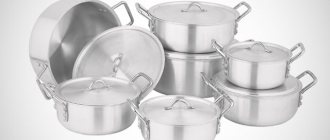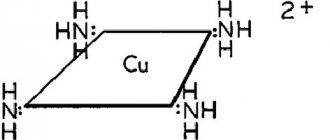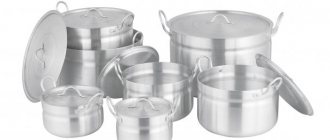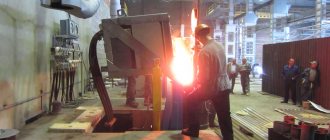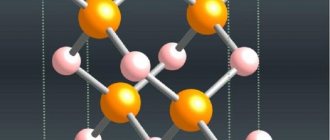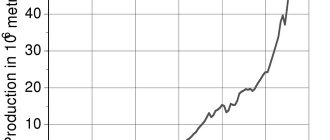Combustion of metals
According to the nature of combustion of metals, they are divided into two groups: volatile and non-volatile.
Volatile metals have relatively low phase transition temperatures - the melting point is less than 1000 K, the boiling point does not exceed 1500 K. This group includes alkali metals (lithium, sodium, potassium, etc.) and alkaline earth metals (magnesium, calcium). The phase transition temperatures of non-volatile metals are much higher. The melting point, as a rule, is above 1000 K and the boiling point is more than 2500 K (Table 1). The combustion mechanism of metals is largely determined by the state of their oxide. The melting point of volatile metals is significantly lower than the melting point of their oxides. Moreover, the latter are quite porous formations.
When the ignition source is brought to the surface of the metal, it evaporates and oxidizes. When the vapor concentration reaches the lower concentration limit, it ignites. The diffusion combustion zone is established at the surface, a large portion of the heat is transferred to the metal, and it is heated to the boiling point. The resulting vapors, freely diffusing through the porous oxide film, enter the combustion zone. Boiling of the metal causes periodic destruction of the oxide film, which intensifies combustion. Combustion products (metal oxides) diffuse not only to the metal surface, promoting the formation of an oxide crust, but also into the surrounding space, where they condense and form solid particles in the form of white smoke. The formation of dense white smoke is a visual sign of burning of volatile metals.
In non-volatile metals with high phase transition temperatures, when burning, a very dense oxide film is formed on the surface, which adheres well to the surface of the metal. As a result of this, the rate of diffusion of metal vapor through the film is sharply reduced and large particles, for example, aluminum and beryllium, are not able to burn. As a rule, fires of such metals occur when they are in the form of shavings, powders and aerosols. They burn without producing dense smoke. The formation of a dense oxide film on the metal surface leads to the explosion of the particle. This phenomenon is especially often observed when particles move in a high-temperature oxidizing environment and is associated with the accumulation of metal vapors under the oxide film, followed by its sudden rupture. This naturally leads to a sharp intensification of combustion.
The main parameters of their combustion are the ignition and combustion time. From the theory of diffusion combustion it follows that the combustion time of a metal particle tg is proportional to the square of its diameter do. Experimental data show that the actual dependence is somewhat different from the theoretical one. So, for aluminum tg
An increase in oxygen concentration in the atmosphere intensifies the combustion of the metal. Aluminum particles with a diameter of (53 ÷ 66) 10 -3 mm in an atmosphere containing 23% oxygen burn in 12.7 10 -3 s, and when the oxidizer concentration increases to 60% - in 4.5 10 -3 s.
However, for fire-technical calculations, it is not the combustion time of a metal particle that is of great interest, but the speed of flame propagation along the flow of a suspension of metal particles in the oxidizer. Table 2 shows experimental data on the speed of flame propagation and the mass burnout rate of a suspension of particles with diameters less than 10 -2 mm and 3·10 -2 mm aluminum in air at different excess air ratios.
Aluminum releases when heated
Aluminum is a combustible metal, atomic weight 26.98; density 2700 kg/m 3, melting point 660.1 °C; boiling point 2486 °C; calorific value -31087 kJ/kg. Aluminum shavings and dust can ignite under the local action of low-calorie ignition sources (match flame, spark, etc.).
When aluminum powder, shavings, and foil interact with moisture, aluminum oxide is formed and a large amount of heat is released, leading to their spontaneous combustion when accumulated in heaps. This process is facilitated by the contamination of these materials with oils. The release of free hydrogen when aluminum dust interacts with moisture facilitates its explosion.
The self-ignition temperature of a sample of aluminum dust with a dispersion of 27 microns is 520 °C; smoldering temperature 410 °C; lower concentration limit of flame propagation 40 g/m 3 ; maximum explosion pressure 1.3 MPa; pressure rise rate: average 24.1 MPa/s, maximum 68.6 MPa/s.
The maximum oxygen concentration at which ignition of the air suspension by an electric spark is excluded is 3% of the volume. Settled dust is a fire hazard. Self-ignition temperature 320 °C. Aluminum easily reacts at room temperature with aqueous solutions of alkalis and ammonia, releasing hydrogen.
Mixing aluminum powder with an alkaline aqueous solution may cause an explosion. Reacts vigorously with many metalloids. Aluminum turnings burn, for example, in bromine, forming aluminum bromide. The interaction of aluminum with chlorine and bromine occurs at room temperature, and with iodine - when heated. When heated, aluminum combines with sulfur.
If you add aluminum powder to the vapor of boiling sulfur, the aluminum will catch fire. Heavily ground aluminum reacts with halogenated hydrocarbons; the small amount of aluminum chloride present (formed during this reaction) acts as a catalyst, accelerating the reaction, in some cases leading to an explosion.
This phenomenon is observed when aluminum powder is heated with methyl chloride, carbon tetrachloride, a mixture of chloroform and carbon tetrachloride to a temperature of about 150 °C.
Aluminum in the form of a compact material does not interact with carbon tetrachloride. Mixing aluminum dust with some chlorinated hydrocarbons and alcohol causes the mixture to spontaneously ignite.
A mixture of aluminum powder with copper oxide, silver oxide, lead oxide and especially lead dioxide burns explosively. A mixture of ammonium nitrate, aluminum powder with coal or nitro compounds is an explosive.
Extinguishing agents: dry sand, alumina, magnesite powder, asbestos blanket. The use of water and fire extinguishers is prohibited.
Aluminum does not occur in nature in its pure form, because it is very quickly oxidized by atmospheric oxygen to form strong oxide films that protect the surface from further interaction.
Aluminum and its alloys are the most common materials among non-ferrous metals and are increasingly used in transport, construction, packaging, electrical engineering and the production of household items. Thanks to their unique set of properties, they successfully withstand competition from other structural materials such as steel, concrete, wood, plastics, glass, etc.
Unfortunately, in Russia, one of the world's largest producers of primary aluminum, the use of aluminum for these purposes lags significantly behind the level of developed countries. Of the 3.76 million tons of aluminum produced last year, only a little more than 600 thousand tons were used in the form of products for domestic consumption in the country. There are several reasons for this.
First of all, the low demand for aluminum products in Russia is due to a significant decline in industrial production.
However, an important role was played by the subordination of consumption in Soviet times to the needs of the military-industrial complex and, as a consequence, the hitherto insufficient awareness of producers and consumers of civilian industrial products about the properties of aluminum, its alloys and their advantages over other materials.
Hence many people have erroneous ideas, for example, about the toxicity or excessively high cost of aluminum, the low corrosion resistance or insufficient mechanical strength of its alloys, etc. And these stereotypes create an obstacle to the use of aluminum in products, structures and machines.
We came across another myth while getting acquainted with the materials of the round table on the problem “Ventilated facades: pros or cons” [1]. During the discussion there, concerns were expressed regarding the use of aluminum for these purposes: they say, “...aluminum-magnesium alloys burn... and materials scientists working in aviation know this very well...”.
Our almost forty years of experience in the aviation industry associated with melting, casting and hot forming of almost all grades of aluminum wrought alloys allows us to judge the fallacy of this statement.
It is known that combustion is a high-temperature oxidation, characterized by a high rate of process and the release of a significant amount of heat. Therefore, ideas about the flammability of aluminum and its alloys are primarily associated with the high affinity of aluminum for oxygen. From Fig.
1 [2] it follows that aluminum differs from copper and iron in its significantly higher heat of oxidation. Its oxide is very stable and is poorly reduced. This property is widely used in metallurgy, where aluminum is used as a deoxidizing agent.
Note that the difference in affinity for oxygen predetermined the chronology of the use of these metals by humanity.
In the Bronze Age, native copper was first used, and then its alloys with tin began to be obtained by inflating the forge with lungs through tubes. To obtain iron, it was necessary to reduce the ore with charcoal in cheese-blowing furnaces.
And only with the advent of electricity it became possible to break the strong bond between oxygen and aluminum and begin the production of this light metal.
It is known that when finely crushed aluminum is heated, it burns vigorously in air
In this case, 31 kJ of energy is released per 1 g of oxidized aluminum, which is slightly less than the heat generated by the combustion of 1 liter of natural gas. The more dispersed the aluminum particles are, the lower the heating temperature is required.
Thus, aluminum powder mixed with oxygen-releasing substances begins to burn intensely at an ignition temperature of 250–300 0C. It is widely used in pyrotechnics and rocket fuel production.
Aluminum powder with particle sizes less than 100 microns dispersed in the air is capable of forming an explosive mixture at room temperature.
Combustion - aluminum
The mass rate of evaporation pggf of the material in the boiling mode is determined by the rate of heat input from the combustion zone, which is proportional to the difference between the combustion temperatures Tg and boiling Tk. Since Tm in the pressure range under consideration almost does not change, and Tk increases with increasing pressure, the difference Tg-Tk decreases with increasing pressure and at the same time the rate of gasification (evaporation) of the metal Tgf a (Tg-TK) / BISIA decreases. Thus, as the pressure increases, the combustion zone approaches the metal surface and vapor-phase combustion may stop. Consequently, during the combustion of aluminum, there is a pressure region in which the mechanism of aluminum combustion is controlled by the rate of its evaporation, and in this region there is a gradual transition from vapor-phase combustion in the presence of boiling to combustion in the absence of boiling, at which reactions on the metal surface can predominate. [31]
The combustion temperature of aluminum close to this value is given in [11, p. According to formula (1.15), which describes the boiling curve, a temperature of 3533 K corresponds to a pressure p 3 22 MPa. From this it is clear that at pressures greater than 3 22 MPa. [33]
Aluminum and its reaction with water
Why is aluminum resistant to corrosion?
Aluminum was first produced only at the beginning of the 19th century. This was done by physicist Hans Oersted. He conducted his experiment with potassium amalgam, aluminum chloride and mercury.
By the way, the name of this silvery material comes from the Latin word “alum”, because it is from them that this element is mined.
Alum is a natural metal-based mineral that combines sulfuric acid salts in its composition.
Previously, aluminum was considered a precious metal and was worth an order of magnitude more expensive than gold. This was explained by the fact that the metal was quite difficult to separate from impurities. So only rich and influential people could afford aluminum jewelry.
But in 1886, Charles Hall came up with a method for extracting aluminum on an industrial scale, which dramatically reduced the cost of this metal and made it possible to use it in metallurgical production. The industrial method involved the electrolysis of molten cryolite in which aluminum oxide was dissolved.
Class D Fires: Do Metals Burn?
The phrase “combustion of metals” causes confusion among many. People who are far from fire safety issues are sure that metals do not burn. However, this is not quite true. Some metals can not only burn, but even spontaneously ignite.
The main dangers posed by different metals are:
- Aluminum is a lightweight electrically conductive metal with a fairly low melting point (660°C), which is why aluminum structures can be destroyed in a fire. But the most dangerous is aluminum powder, which carries the threat of explosion and can burn.
- Cadmium and many other metals emit toxic fumes when exposed to high temperatures. Therefore, extinguishing burning metals should be done with protective masks.
- Alkali metals (sodium, potassium, lithium) react with water, forming hydrogen and the amount of heat required to ignite it.
- Powdered cast iron may explode when exposed to high temperatures or fire. Sparks from cast iron can ignite flammable materials nearby.
- Steel, which is not considered a combustible metal, can also catch fire if it is in powder or sawdust form.
- Titanium is a strong metal, the main element of steel alloys. It melts at high temperatures (2000°C) and does not burn in large structures or products. But small titanium parts can easily catch fire.
- Magnesium is one of the main elements in light alloys, giving them ductility and strength. Magnesium flakes and powder may burn. Solid magnesium can also ignite, but only if heated to temperatures above 650°C.
As you can see, mainly crushed metals in the form of powder, shavings, and sawdust can burn. In addition to these hazards, metals can also cause injury, burns, and injury to people.
D Fires
Class D combustion occurs on the metal surface at a very high temperature and produces strong sparks.
Water as a fire extinguishing agent is completely unsuitable for metal products and powders, since many of them react with it, as a result of which the fire can only intensify. Also, getting water on burning metal can cause it to splash onto people and surrounding objects.
Sand should also not be used to extinguish burning metals. Its use may cause the two materials to interact and increase combustion.
To extinguish metals, special dry powders are most often used. Moreover, for each metal it is necessary to select its own composition.
The combustion of magnesium and alloys based on it is suppressed by dry ground fluxes used in their smelting. Fluxes help separate the source of fire from the air using the resulting liquid film.
Aluminum oxide: preparation and properties
Aluminium oxide
Methods of obtaining
Aluminum oxide can be obtained by various methods:
1. By burning aluminum in air:
2. Decomposition of aluminum hydroxide when heated:
3. Aluminum oxide can be obtained by decomposition of aluminum nitrate :
Chemical properties
Aluminum oxide is a typical amphoteric oxide . Interacts with acidic and basic oxides, acids, alkalis.
1. When aluminum oxide interacts with basic oxides, aluminate salts are formed .
For example , aluminum oxide reacts with sodium oxide :
2. Aluminum oxide reacts with soluble bases (alkalis). In this case, salts are formed in the melt - aluminates, and in the solution - complex salts . In this case, aluminum oxide exhibits acidic properties .
For example , aluminum oxide reacts with sodium hydroxide
in the melt to form
sodium aluminate and water :
Aluminum oxide dissolves in excess alkali to form tetrahydroxyaluminate :
3. Aluminum oxide does not react with water.
4. Aluminum oxide reacts with acidic oxides (strong acids). In this case, aluminum salts In this case, aluminum oxide exhibits basic properties .
For example , aluminum oxide reacts with sulfur(VI) oxide to form aluminum sulfate:
5. Aluminum oxide reacts with soluble acids to form medium and acid salts .
For example , aluminum oxide reacts with sulfuric acid :
6. Aluminum oxide exhibits weak oxidizing properties .
For example , aluminum oxide reacts with calcium hydride to produce aluminum , hydrogen and calcium oxide :
Electric current reduces aluminum from oxide (aluminum production):
7. Aluminum oxide - solid, non-volatile. Consequently, it displaces more volatile oxides (usually carbon dioxide) from the salts during fusion.
For example , from sodium carbonate :
Source
Classification
Most combustion products are toxic substances. Therefore, speaking about their classification, it would be correct to introduce you to the following term:
Classification of the danger of substances according to the degree of impact on the body is the establishment (ranking) of the levels of danger of substances according to their damaging and damaging effects on the human and (or) animal body. Read more about this classification in the material at the link >>
Also check out the educational material on the topic:
Formulas for calculating volume
The type of formula for calculating the volume of complete combustion products with a theoretically required amount of air depends on the composition of the combustible substance.
Individual chemical compound
In this case, the calculation is carried out based on the combustion reaction equation. The volume of wet combustion products per unit mass (kg) of a combustible substance under normal conditions is calculated using the formula:
Vp.s. – volume of wet combustion products, m 3 /kg;
– the number of kilomoles of carbon dioxide, water vapor, nitrogen and combustible substances in the combustion reaction equation;
M
is the mass of a flammable substance, numerically equal to the molecular mass, kg.
For example, to determine the volume of dry combustion products of 1 kg of acetone under normal conditions, we create an equation for the combustion reaction of acetone in air:
Determine the volume of dry combustion products of acetone:
The volume of wet combustion products of 1 m 3 of combustible substance (gas) can be calculated using the formula:
Vp.s. – volume of wet combustion products of 1 m 3 of combustible gas, m 3 / m 3;
– number of moles of carbon dioxide, water vapor, nitrogen and flammable substance (gas).
Complex mixture of chemical compounds
If the elemental composition of a complex combustible substance is known, then the composition and amount of combustion products of 1 kg of substance can be determined from the equation of the combustion reaction of individual elements. To do this, equations are drawn up for the combustion reaction of carbon, hydrogen, sulfur and the volume of combustion products per 1 kg of combustible substance is determined. The combustion reaction equation has the form:
C + O 2 + 3.76N 2 = CO 2 + 3.76N 2
When 1 kg of carbon is burned, 22.4 / 12 = 1.86 m 3 CO 2 and 22.4 × 3.76/12 = 7.0 m 3 N 2 are obtained.
The volume (in m3) of combustion products of 1 kg of sulfur and hydrogen is determined in the same way. The data obtained is shown below:
When carbon, hydrogen and sulfur burn, oxygen comes from the air. However, the combustible substance may contain oxygen, which also takes part in combustion. In this case, correspondingly less air is consumed for combustion of the substance.
The combustible substance may contain nitrogen and moisture, which during the combustion process become combustion products. To account for them, it is necessary to know the volume of 1 kg of nitrogen and water vapor under normal conditions.
The volume of 1 kg of nitrogen is 0.8 m3, and the volume of water vapor is 1.24 m3. In air at 0 °C and a pressure of 101325 Pa, per 1 kg of oxygen there is 3.76 × 22.4 / 32 = 2.63 m 3 of nitrogen.
Based on the given data, the composition and volume of combustion products of 1 kg of combustible substance are determined.
For example, to determine the volume and composition of wet combustion products of 1 kg of coal, consisting of 75.8% C, 3.8% H, 2.8% O, 1.1% N, 2.5% S, W = 3 .8%, A = 11.0%.
The volume of combustion products will be as follows, m3:
| Composition of combustion products | CO2 | H2O | N2 | SO2 |
| Carbon | 1,86 × 0,758 = 1,4 | – | 7 × 0,758 = 5,306 | – |
| Hydrogen | – | 11,2 × 0,038 = 0,425 | 21 × 0,038 = 0,798 | – |
| Sulfur | – | – | 2,63 × 0,025 = 0,658 | 0,7 × 0,025 = 0,017 |
| Nitrogen in combustible substance | – | – | 0,8 × 0,011 = 0,0088 | – |
| Moisture in a flammable substance | – | 1,24 × 0,03 = 0,037 | – | – |
| Sum | 1,4 | 0,462 | 6,7708 – 0,0736 = 6,6972 | 0,017 |
From the total volume of nitrogen, subtract the volume of nitrogen attributable to oxygen in the composition of coal: 0.028 × 2.63 = 0.0736 m3. The result indicates the composition of the combustion products of coal: the volume of wet combustion products of 1 kg of coal is equal to:
Vp.s. = 1.4 + 0.462 + 6.6972 + 0.017 = 8.576 m 3 /kg.
Mixture of gases
The amount and composition of combustion products for a mixture of gases is determined by the equation of the combustion reaction of the components that make up the mixture. For example, methane combustion proceeds according to the following equation:
CH 4 + 2O 2 + 2 × 3.76N 2 = CO 2 + 2H 2O + 7.52N 2
Effect on the human body
The degree of toxicity of substances is related to their physical and chemical nature. Interacting with the body, combustion products cause pathological syndromes.
The International Classification of Diseases, Tenth Revision ICD-10, defines poisoning by combustion products with code T59 - “Toxic effects of other gases, fumes and vapors.”
According to the mechanism of action on humans, toxic components in smoke are divided into five groups.
- Substances that cause damage to the skin and mucous membrane. Symptoms of such poisoning by combustion products are itching, burning of the skin and its inflammation, pain in the eyes, eyelids, lacrimation, cough. Examples are tar fumes, sulfur dioxide, formaldehyde.
- Combustion products that cause acute inhalation poisoning. The victims complain of shortness of breath and cough. Upon examination, rapid breathing and cyanosis are noteworthy. High concentrations of toxic gas may cause respiratory arrest. Thus, signs of poisoning by PVC combustion products may appear within a few hours. Inhalation poisoning is caused by chlorine, ammonia, and nitric oxide.
- Combustion products produce toxic substances, which are called “blood poisons.” By binding hemoglobin, they disrupt the access of oxygen to tissues and trigger pathological reactions that affect the entire body. Examples: carbon monoxide, nitrogen dioxide.
- Combustion products for which the target organ is the nervous system. This is benzene, hydrogen sulfide.
- Enzyme poisons that affect tissue respiration, blocking oxygen activation processes. This is hydrogen sulfide, hydrocyanic acid.
Many toxins that form in combustion products are “universal”, since they cause damage to several body systems at once.
